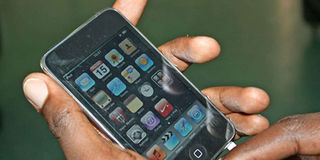How cell phone data can track Covid-19

As we go about our daily lives, mobile phones continuously track our movements and our location at any one time. PHOTO | FILE | NATION MEDIA GROUP
What you need to know:
- Health officials used these data to identify the Ebola hotspots, which were then isolated, locked down, and sick individuals identified and taken to hospital.
- Phone data can also tell whether quarantined people are moving from their quarantine location before they are declared virus-free.
As Covid-19 stretches its fingers across the world and crushes those in its grip, scientists are all-hands-on-deck, working across time zones seeking solutions.
Disease scientists of every hue are at the outmost edge of science, developing a vaccine to calm a world on edge.
In stopping a pandemic, public health officials want to find out where and how the disease emerges and spreads. With this type of information, the battle is half-way won.
Without it, they are flying blind while the virus continues its menace. Unlike in the previous epidemics that killed millions, now we have the benefit of technology, a force multiplier.
Technology empowers communication, hastens the quest for a vaccine, and turbocharges disease prevention methods.
In the 2014 Ebola outbreak in West Africa, for example, cell phone data were used to track the movements of people who had been in contact with people sick with the Ebola virus.
Health officials used these data to identify the Ebola hotspots, which were then isolated, locked down, and sick individuals identified and taken to hospital.
EFFECTIVE INTERVENTIONS
As we go about our daily lives, mobile phones continuously track our movements and our location at any one time.
Such data — including unique mobile phone ‘pings’ from cell phone towers — can show where people have travelled after leaving a disease hot spot.
Such movements, when carefully tracked, can suggest where a new disease cluster might be forming. Such data also inform on whether people are abiding by the stay-at-home ordinance or the curfew.
Austria, Belgium, Italy, the UK, and Germany are all reportedly gathering aggregated location data from telecom companies to help trail the coronavirus contacts.
Phone data can also tell whether quarantined people are moving from their quarantine location before they are declared virus-free. For example, Taiwan’s authorities get alerts when a quarantined person moves too far away from their home.
This way, public health officials can easily find residential areas, workplaces, churches, entertainment, bus parks, and other places of interest, and create a firebreak to Covid-19 firestorm. That information is a guiding light for effective public health interventions.
PRIVACY CONCERNS
But, the harvesters of mobile phone data must balance between privacy concerns arising from accessing a person’s mobile phone data, and public health concerns.
They must use it only for the public good without infringing on personal liberties. Given that the coronavirus has already sickened almost two million people and killed almost 100,000, data privacy concerns may take a backseat until the pandemic runs its course.
Here is my point: the world is grappling with an existential crisis that requires the use of all tools at our disposal. Effective contact-tracing is the yin and the yang for stopping intractable viral diseases.
Mobile phone-harvested data can be a boon in tracking movements of people, and in so doing helping health workers in their quest to stop the pandemic.
Mr Wambugu is an informatician. Email:[email protected] Twitter: @samwambugu2





